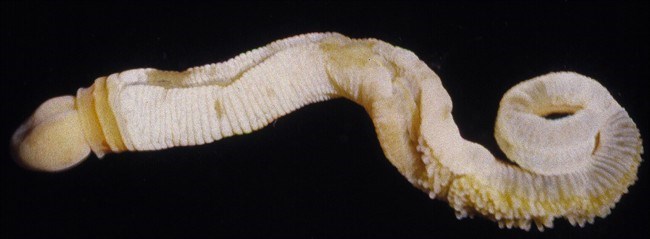TORONTO - Researchers have unearthed evidence of a strangely shaped creature — OK, it looks like a phallus — that lived more than 500 million years ago in the famed Burgess Shale fossil beds in B.C.'s Yoho National Park.
However, it's not just its form that makes the ancient animal so intriguing, but the fact that the newly discovered species pushes the fossil record back 200 million years to the Cambrian period and fills in an evolutionary blank that connects it with a group of modern-day beach-dwelling worms.
These acorn worms — known scientifically as enteropneusts — are decidedly phallic in appearance.
Their ancient forerunner, dubbed Spartobranchus tenuis, had a flexible body consisting of a short proboscis, collar and narrow elongate trunk terminating in a bulbous structure, which may have served as an anchor.
The animals would have lived in or on a silt-covered sea bottom an estimated 505 million years ago. They were likely quickly buried by mud flows that preserved them surprisingly well, despite having bodies that contained no skeletons that could mineralize, as was the case with dinosaurs.
"Unlike animals with teeth and bones, these spaghetti-shaped creatures were soft-bodied, so the fossil record for them is extremely scarce," said lead researcher Jean-Bernard Caron, a paleontologist at the Royal Ontario Museum in Toronto.
"What's striking about this fossil is actually it is quite similar to modern forms," he said. "Despite 500 million years of evolution, this particular group of animal has not really changed much since the first forms that we found here fossilized in the Burgess Shale."
The largest specimens found are 10 centimetres long, with the proboscis accounting for about half a centimetre. Many of these worms were preserved in tubes, some of which were branched, suggesting the tubes had been constructed by the animals and used as dwelling places.
"It's astonishing how similar Spartobranchus tenuis fossils are to modern-day acorn worms, except that they also formed fibrous tubes," which acorn worms do not, said co-author Christopher Cameron, an evolutionary biologist at the University of Montreal and a world expert in enteropneusts.
Another modern-day creature, a tiny deep-sea animal called a pterobranch that lives in colonies and also builds and lives in similar fibrous tubes, has been shown to be genetically related to acorn worms. Yet previously no one could decipher how the vastly different-looking organisms could possibly be connected.
Cameron said Spartobranchus supplies that answer: it appears to be a common ancestor to both acorn worms and pterobranchs — in other words, the missing link between the two specie groups.
The new finding, published online Wednesday in the journal Nature, confirms Spartobranchus tenuis is a member of the acorn worms group.
Acorn worms live in fine sand and mudflats of both shallow and deeper waters and are seldom seen. They are hemichordates, marine animals that are closely related to today's sea stars and sea urchins.
Acorn worms graze on sand or mud to extract organic matter or feed on material suspended in the water.
Caron said Spartobranchus tenuis probably fed on small particulate matter at the bottom of the oceans.
“There are literally thousands of specimens at the Walcott Quarry in Yoho National Park, so it’s possible Spartobranchus tenuis may have played an important role in recycling organic matter in the early Burgess Shale environment, similar to the ecological service provided by earth worms today on land."
The Burgess Shale is part of Yoho National Park in the Rocky Mountains. A UNESCO World Heritage Site, it contains one of the planet's most important fossil deposits for understanding the origin and early evolution of animals during the so-called Cambrian Explosion that began about 542 million years ago.
———
Online: www.burgess-shale.rom.on.ca



